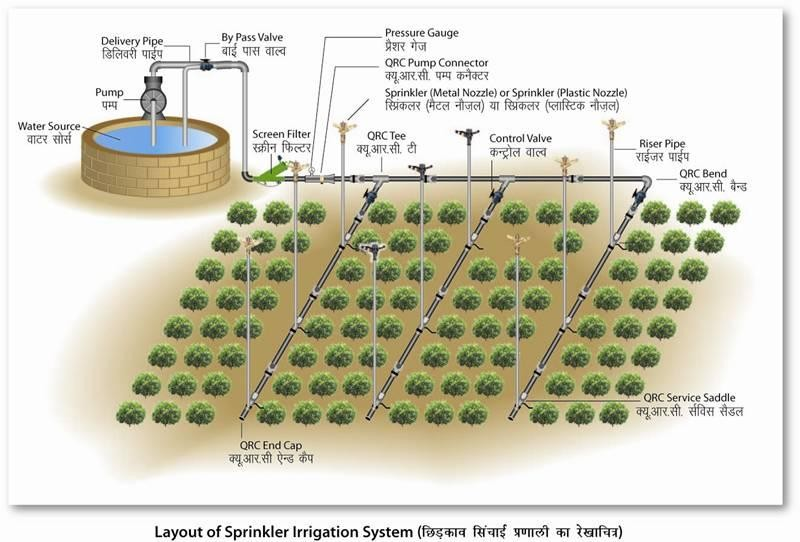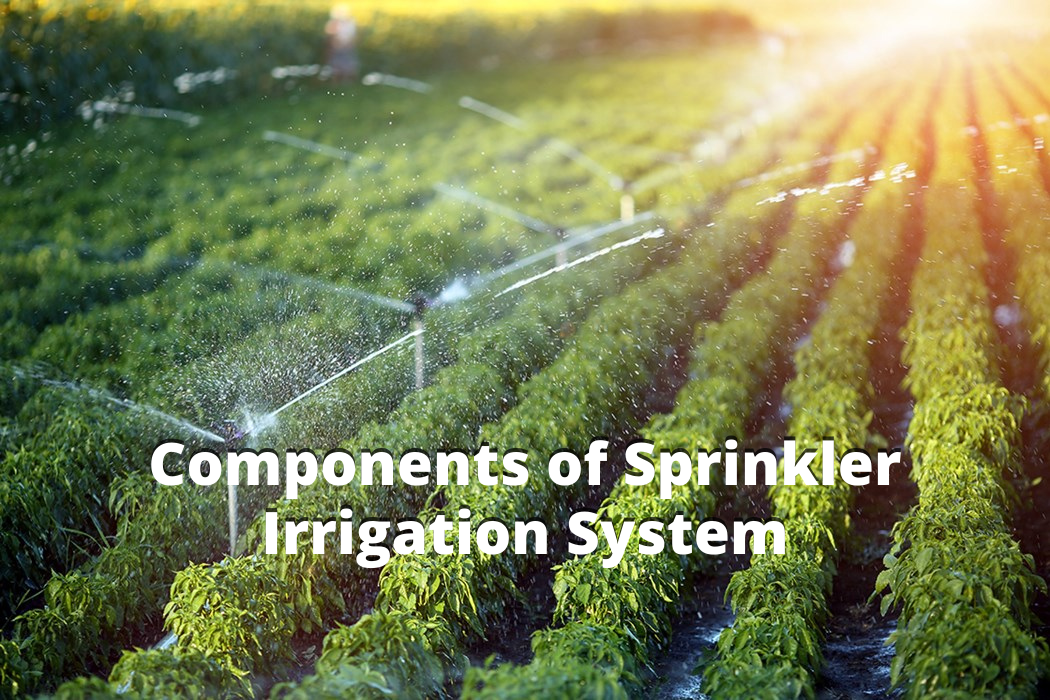Main Component of Drip Irrigation Systems

Components of the sprinkler irrigation system:
- Sprinkler irrigation maintains moisture in the soil. Moisture is essential for the germination of seeds.
- Water supplies two essential elements, hydrogen & oxygen to the crop
- Irrigation is essential for the absorption of mineral nutrients by the plants from the soil.
- It is important for the growth of the roots of the crop plants.
Components of the sprinkler irrigation system:
- A pump unit
- tubing- main/sub-mains and laterals
- Couplers
- Sprinkler head
- Other accessories such as valves, bends, plugs & risers
1.Pumping Unit:
The sprinkler irrigation method distributes water by spraying it over the fields. The pressure forces the water through sprinklers or through perforations or nozzles in pipelines & then forms a spray. A high-speed centrifugal or turbine pump used for operating sprinkler irrigation for individual fields. A centrifugal pump is used when the distance from the pump inlet to the water surface is less than 8 meters. For pumping water from deep wells or more than 8 meters, a turbine pump is suggested. The driving part may be either an electric motor or an internal combustion engine.
2. Tubing:
Mains or sub mains and laterals: The tunings consist of mainline, sub-mains & laterals. The mainline conveys water from the source & distributes it to the sub-mains. The sub-mains convey water to the laterals which in turn provide water to the sprinklers. Aluminum or PVC pipes are normally used for portable systems, while steel pipes are generally used for center-pivot laterals. Asbestos, cement, PVC & wrapped steel are generally used for buried laterals and main lines.
3. Couplers:
Couplers are used for connecting two pipes & uncoupling quickly and easily. Basically, couplers should provide this.
(a) Reuse and flexible relation
(b) Not leak at the point of the joint
(c) Be simple and easy to couple & uncouple
(d) Be light, non-corrosive, durable.
4. Sprinkler Head:
Sprinkler head distributes water evenly over the field without runoff or excessive loss due to deep percolation. Different types of sprinklers are obtainable. They are either rotating type or fixed type. The rotating type can be adapted for a wide range of application rates & spacing. They are effective with a pressure of about 10 m – 70 m head at the sprinkler. Pressures ranging from 16 m to 40 m head are considered the most practical for most farmers. Fixed head sprinklers are normally used to irrigate small lawns and gardens. Perforated lateral lines are used as sprinklers. They need less pressure than rotating sprinklers. They discharge more water per unit area than rotating sprinklers. Hence, fixed head sprinklers are flexible for soils with a high intake rate.
5. Fittings and accessories:
The following are some of the main fittings & accessories used in the sprinkler system.
(a) Water meters: It is used to determine the volume of water delivered. This is required to operate the
(b) system to give the required quantity of water.
(c) Flange, couplings, and nipple used for proper connection to the pump, suction & delivery.
(d) Pressure gauge: It is essential to know whether the sprinkler system is working with the desired.
(e) pressure to ensure application uniformity.
(f) Bend, tees, reducers, elbows, hydrants, butterfly valve & plugs.
(g) Fertilizer applicator: Soluble chemical fertilizers can be injected into the sprinkler system & applied to the crop. The equipment for fertilizer application is relatively cheap, simple, and can be fabricated locally. The fertilizer applicator consists of a sealed fertilizer tank with essential tubing & connections. A venture injector can be arranged in the mainline, which creates the differential pressure suction & allows the fertilizer solution to flow in the main water line.
Climate conditions for the Sprinkler irrigation system:
Climatic conditions such as temperature, humidity, wind velocity of a place have a huge influence on the consumptive use of a crop. The sprinkler irrigation system should be designed for the peak rate for consumptive use of crops to be irritated by it. In areas where wind velocities & temperatures are high, heavy evaporation losses from the sprinkler sprays considerably reduce the saving of water. The wind influences the spacing of sprinklers. Therefore, it is essential to recognize the velocity of wind and its direction. For wind velocities over 16 km/hour, the sprinkler method becomes unsuitable. You may also check this: Tea Powder Making Process from Green Tea Leaves.
Suitable crops for the Sprinkler irrigation system:
Sprinkler irrigation is suited for a most row, field, and tree crops & water can be sprayed over or under the crop canopy. Large sprinklers are not optional for the irrigation of delicate crops such as lettuce since the large water drops produced by the sprinklers may damage the crop. Almost all crops are suitable for sprinkler irrigation systems except crops such as paddy, jute, etc. The dry crops, flowering crops, orchards, plantation crops such as tea, coffee are all suitable & can be irrigated through sprinklers.
Suitable soils for the Sprinkler irrigation system:
Sprinklers are best suitable to sandy soils with high infiltration rates, although they are adaptable to most soils. The average application rate from the sprinklers (in mm/hour) is always selected to be less than the basic infiltration rate of the soil so that surface ponding & runoff can be avoided. Sprinklers are not fit for soils that easily form a crust. If the sprinkler irrigation system is the only method available, then light fine sprays should be used. The larger sprinklers generate larger water droplets that are to be avoided.


how to get free tiktok likes and followers February 16, 2024
I do trust all of the ideas you have offered for your post.
They are really convincing and can certainly work.
Nonetheless, the posts are too brief for newbies.
May you please lengthen them a little from next time?
Thank you for the post.
20 instagram followers February 16, 2024
Hi all, here every one is sharing such know-how, so it’s good to read this website,
and I used to visit this weblog all the time.